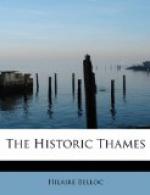For example, though we cannot tell exactly when Maidenhead Bridge was built, we may suppose it to have been some few years after Henley Bridge. It already exists and is in need of repair in 1297. Henley Bridge is founded more than a generation earlier than that.
“Maidenhythe,” as it was called, has been thought to have been before the building of this bridge a long timber wharf upon the river, but that is only a guess. There must have been some local accumulation of wealth or of traffic or it would not have been chosen as a site for the new bridge which was somewhat to divert the western road.
Originally, so far as we can judge, the main stream of gravel crossed the Thames at Cookham, and again at Henley. Why this double crossing should have been necessary it is useless to conjecture unless one hazards the guess that the quality of the soil in very early times gave so much better going upon the high southern bank of the river that it was worth while carrying the main road along the bank, even at the expense of a double crossing of the stream. If that was the case it is difficult to see how a town of the importance of Marlow could have grown up upon the farther shore; that Marlow was important we know from the fact that it had a Borough representation in Parliament in the first years of that experiment before the close of the thirteenth century.
At any rate, whatever the reason was, whether from some pre-historic conditions having brought the road across the peninsula at this point, or, as is more likely, on account of some curious arrangement of mediaeval privilege, it is fairly certain that, in the centuries before the great development of the thirteenth, travel did come across the river in front of Cookham, recross it in front of Henley, and so make over the Chilterns to the great main bridge at Wallingford, which led out to the Vale of the White Horse and the west country.
The importance of Cookham in this section of the road is shown in several ways. First the great market, in Domesday bringing in customary dues to the King of twenty shillings—and what twenty shillings means in Domesday in mere market dues one can appreciate by considering that all the dues from Old Windsor only amounted to ten pounds. Then again it was a royal manor which, unlike most of the others, was never alienated; it was not even alienated during the ruin and breakdown of the monarchy which followed the Dissolution of the monastic orders.
To this day traces remain of the road which joined this market to the second crossing at Henley.
We may presume that the importance of Cookham was maintained for some two centuries after the Conquest, until it was outflanked and the stream of its traffic diverted by the building of the bridge at Maidenhead.




